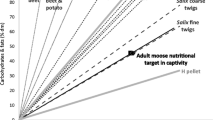Abstract
The giving-up density of food (GUD), the amount of food remaining in a patch when a forager ceases foraging there, can be used to compare the costs of foraging in different food patches. But, to draw inferences from GUDs, specific effects of foraging costs (predation risk, metabolic and missed opportunities costs) on GUDs have to be identified. As high predation risk, high metabolic costs and abundant food all should produce high GUDs, this does not allow us to infer directly the quality of a habitat. In order to separate the effect of each foraging cost, we developed an optimal foraging model based on food supplementation. We illustrate the use of our model in a study where we assessed the impact of a power line right-of-way in a white-tailed deer (Odocoileus virginianus) winter yard by determining whether the negative effects of cover loss outweigh the positive effects of browse regeneration.


Similar content being viewed by others
References
Abramsky Z, Strauss E, Subach A, Kotler BP, Riechman A (1996) The effect of barn owls (Tyto alba) on the activity and micro-habitat selection of Gerbillus allenbyi and G. pyramidum. Oecologia 105:313–319
Altendorf KB, Laundré JW, López González CA, Brown JS (2001) Assessing effects of predation risk on foraging behaviour of mule deer. J Mammal 82:430–439
Brown JS (1992) Patch use under predation risk: I. Models and predictions. Oikos 54:33–43
Brown JS (1988) Patch use as an indicator of habitat preference, predation risk and competition. Behav Ecol Sociobiol 22:37–47
Dumont A, Ouellet JP, Crête M, Huot J (1998) Caractéristiques des peuplements forestiers recherchés par le cerf de Virginie en hiver à la limite nord de son aire de répartition. Can J Zool 76:1024–1036
Garant Y (1992) Les emprises de lignes dans les ravages de cerfs de Virginie. Production de nourriture et utilisation par le cerf de Virginie. Ravage de Bedford, Rigaud, Hill Head, Kingsey Falls, Rawdon, lac David, Notre-Dame-du-Laus, lac du Trente-et-Un-Mille et Watopeka. - Service Ressource et Aménagement du territoire, Direction Recherche et Encadrements, vice-présidence Environnement, Hydro-Québec. 56 p
Gaston G, Bélanger L, Potvin F (1990) Caractérisation des ravages de cerfs de Virginie de l’est du Québec. Ministère du loisir, de la chasse et de la pêche, Direction de la gestion des espèces et des habitats. 88 p
Harper JA (1971) Ecology of Roosevelt elk. Oreg. State Game Comm. 44 p
Hepburn RL (1978) A snow penetration gauge for studies of white-tailed deer and other northern mammals. J Wildl Manage 42:663–667
Jacob J, Brown JS (2000) Microhabitat use, giving-up densities and temporal activity as short- and long-term anti-predator behaviors in common voles. Oikos 91:131–138
Kilpatrick AM (2003) The impact of thermoregulatory costs on foraging behaviour: a test with American Crows (Corvus brachyrhynchos) and eastern grey squirrels (Sciurus carolinensis). Evol Ecol Res 5:781–786
Kotler BP, Brown JS (1999) Mechanisms of coexistence of optimal foragers as determinants of local abundances and distributions of desert granivores. J Mammal 80:361–374
Kotler BP, Brown JS, Bouskila A (2004) Apprehension and time allocation in gerbils: the effects of predatory risk and energetic state. Ecology 85:917–922
Kotler BP, Brown JS, Hickey M (1999) Food storability and the foraging behavior of fox squirrels (Sciurus niger). Am Midl Nat 142:77–86
Kotler BP, Gross JE, Mitchell WA (1994) Applying patch use in Nubian ibex to measure resource assessment ability, diet selection, indirect interactions between food plants, and predatory risk. J Wildl Manage 58:300–308
Lima SL, Dill LM (1990) Behavioral decisions made under the risk of predation: a review and prospectus. Can J Zool 68:619–640
Murden SB, Risenhoover KL (1993) Effects of habitat enrichment on patterns of diet selection. Ecol Appl 3:497–505
Olsson O, Molokwu MN (2007) On the missed opportunity cost, GUD, and estimating environmental quality. Isr J Ecol Evol 53:263–278
Olsson O, Holmgren NMA (1999) Gaining ecological information about Bayesian foragers through their behaviour. I. Models with predictions. Oikos 87:251–263
Rieucau G, Vickery WL, Doucet GJ, Laquerre B (2007) An innovative use of white-tailed deer (Odocoileus virginianus) foraging behaviour in impact studies. Can J Zool 85:839–846
Rooney TP, Waller DM (2003) Direct and indirect effects of white-tailed deer in forest ecosystems. For Ecol Manag 181:165–176
Sabine DL, Forbes G, Ballard WB, Bowman J, Whitlaw H (2001) Use of mixedwood stands by wintering white-tailed deer in southern New Brunswick. For Chron 77:97–103
Shochat E, Lerman SB, Katti M, Lewis DB (2004) Linking optimal foraging behavior to bird community structure in an urban-desert landscape: field experiments with artificial food patches. Am Nat 164:232–243
Schmitz OJ (1991) Thermal constraints and optimization of winter feeding and habitat choice in white-tailed deer. Ecography 14:104–111
Stenberg M, Persson A (2006) Patch use behaviour in benthic fish depends on their long-term growth prospects. Oikos 112:332–341
Stephens DW, Krebs JR (1986) Foraging Theory. Princeton University Press, Princeton, New Jersey
Valone TJ, Brown JS (1989) Measuring patch assessment abilities of desert granivores. Ecology 70:1800–1810
Whelan CJ, Jedlicka DM (2007) Augmenting population monitoring programs with behavioral indicators during ecological restorations. Isr J Ecol Evol 53:279–295
Acknowledgements
This study was supported by Hydro-Québec. We sincerely thank S. Gagnon for his technical assistance and dedication in the field. We also thank J.M. McNamara, B.P. Kotler, J. S. Brown and an anonymous reviewer for their useful comments.
Author information
Authors and Affiliations
Corresponding author
Additional information
Communicated by J. Lindström
Rights and permissions
About this article
Cite this article
Rieucau, G., Vickery, W.L. & Doucet, G.J. A patch use model to separate effects of foraging costs on giving-up densities: an experiment with white-tailed deer (Odocoileus virginianus). Behav Ecol Sociobiol 63, 891–897 (2009). https://doi.org/10.1007/s00265-009-0732-7
Received:
Revised:
Accepted:
Published:
Issue Date:
DOI: https://doi.org/10.1007/s00265-009-0732-7




